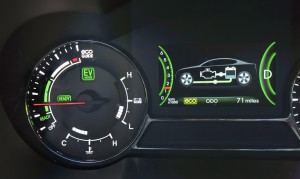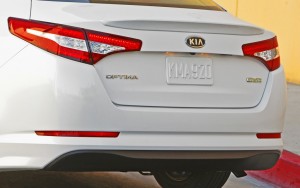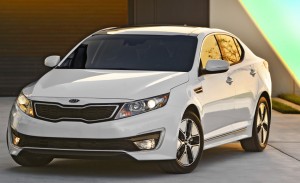
The Kia Optima Hybrid advances the state of the art for hybrids by allowing the gas engine to shut off at higher speeds.
As automakers get better at making electrified cars, the line is going to start to blur between hybrids, extended-range electric vehicles and electric cars.
Take this Kia Optima Hybrid. The early hybrids could hardly attain or maintain any speed with the gas engine shut off. Soon, hybrids were able to maintain 25 mph on electric power alone and then the mid-40s. But the goal for any hybrid is to drive longer distances with their gas engine turned off.
It just makes sense. If the gasoline engine isn’t running, the car uses less fuel.
So we were somewhat surprised to watch the EV Mode light glow – at 80 mph – for brief stretches along I-94 near Ann Arbor after returning from a concert. The engine never stayed off for long, and even the hint of a hill caused the engine to restart.
What was truly amazing was the Optima’s complete seamlessness with which it transitioned back and forth between gasoline and electric power, even at freeway speeds. There is literally no way to discern when the engine starts, other than watching the tachometer lift off 0 rpm and EV Mode light go dark.
The gasoline-electric powertrain has come a long way in just 13 years since the first Honda Insight hit the U.S. market in 1999.
The Optima’s ability to shut off its engine at higher speeds is why – unlike many hybrids – the Optima carries a higher freeway fuel mileage rating than its city rating. It’s rated at 35 city and 40 highway. We saw 33 mpg in a combination of freeways and rural two-lanes.
While the Optima’s transition at high speed is exemplary, the automaker needs to do more work on the system at lower speeds. The transmission often seems to be caught off guard and the powertrain generally has an unpleasant jerkiness. Interestingly, the Optima seemed worse in normal mode than in Eco, which is accessed via a steering wheel button.
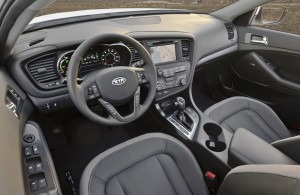
The Optima Hybrid's interior is similar to the regular car, meaning it's well finished and comfortable.
Kia decided to go with a traditional six-speed automatic transmission rather than a continuously variable transmission as is used in most hybrids. That decision probably costs the Optima a mile per gallon or two, but most drivers prefer a regular geared transmission to a CVT’s droning.
As is typical for many hyper milers, the Optima Hybrid is in no hurry when it comes to acceleration, but it’s acceptable for most drivers. Unfortunately, the powertrain typically hesitates after pressing the right pedal, particularly from a stop.
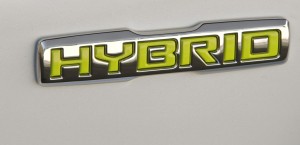 Kia did a better job tuning the hybrid’s regenerative braking system, often one of the most difficult aspects for hybrid engineers to develop. The brakes only feel grabby at very low speeds, such as in a driveway.
Kia did a better job tuning the hybrid’s regenerative braking system, often one of the most difficult aspects for hybrid engineers to develop. The brakes only feel grabby at very low speeds, such as in a driveway.
The Optima Hybrid starts at $27,250, including destination, a $5,500 premium over the base Optima LX, but that price includes additional standard features, such as keyless start, UVO infotainment system and LED taillights. A more direct comparison would be the midlevel EX, which starts at $23,950 and comes with standard features similar to the hybrid model.
Besides the hybrid powertrain, this Optima would be familiar to anyone who’s spent time with any of the other Optima models, the standard four cylinder, and the turbo four cylinder.
The sleek exterior design looks fast and high-tech and unlike just about anything else on the road.
Inside, the dash design is more upright than most current cars, but it’s stylish and well finished. The hybrid model comes with a lot of standard equipment including a 4.3-inch touchscreen, automatic headlights, dual-zone climate control, keyless start, satellite radio, multi-function screen to monitor the hybrid function and Bluetooth. A glaring omission in this base car was no compass, which has become a fairly common feature in most midlevel cars these days. The test car was also equipped with UVO, Kia’s answer to the Ford Sync voice command system. UVO isn’t as advanced as Sync and cannot understand as many commands as the Ford system. But its voice-recognition system is good, possibly better than Ford’s.
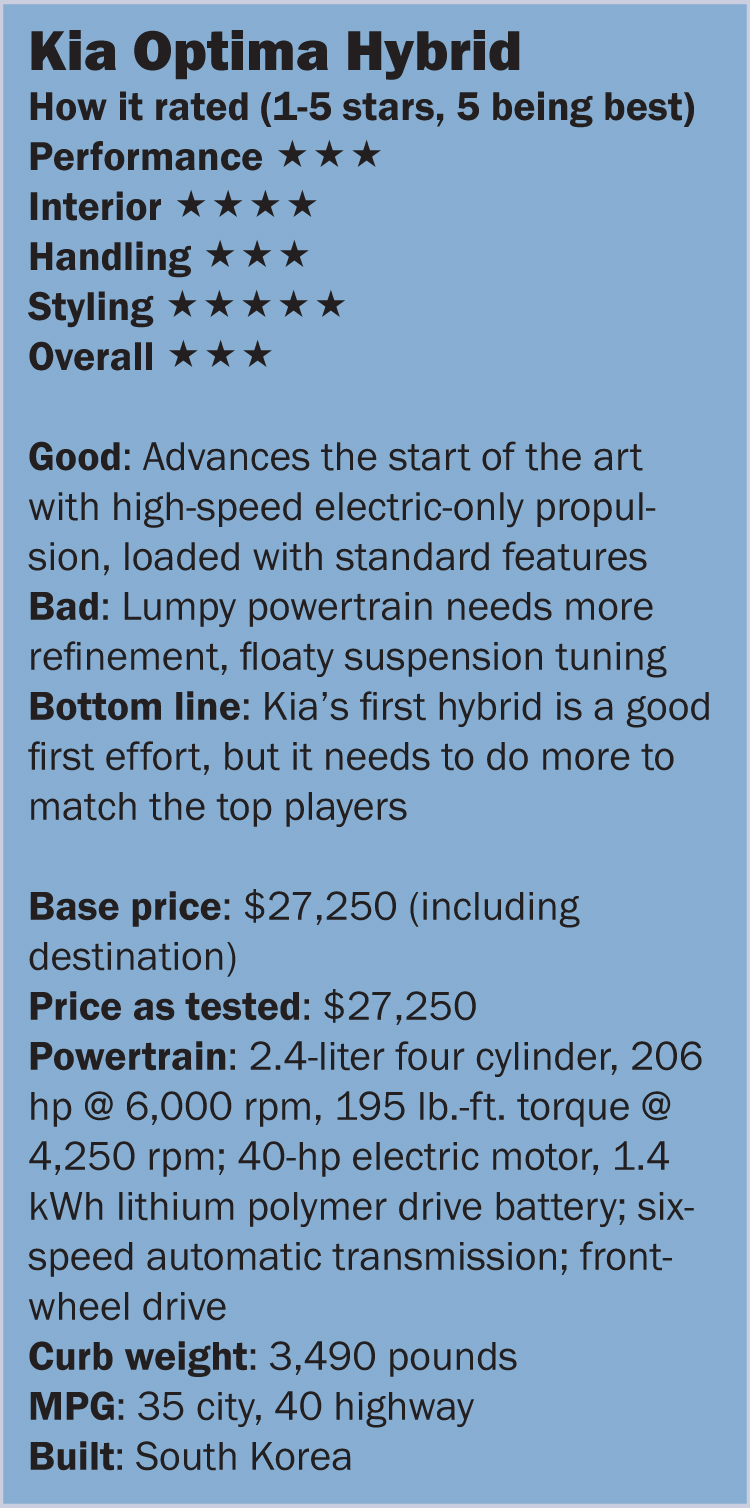 Rear-seat room headroom is a bit compromised by the rakish roofline, but legroom is good and the seats are comfortable.
Rear-seat room headroom is a bit compromised by the rakish roofline, but legroom is good and the seats are comfortable.
A typical Kia demerit, the Optima Hybrid could use a bit more development from the ride-and-handling engineers. It feels floaty, particularly in front, although the ride is harsher than one might expect considering the wafty handling.
While the Optima Hybrid helps advance the state the art, there’s plenty of room for improvement. Like other hybrids, accelerating without the gas engine firing, even in neighborhoods takes a very light and deliberate right foot. And while the Optima is able to shut its engine off occasionally at freeway speeds, there are many times when it would seem that it could shut off, but doesn’t.
The blurring of the line between traditional hybrids and extended-range electrics has already begun. Tomorrow’s hybrids will spend more and more time with their gasoline engines silent, their electric motors providing the power to accelerate and maintain speed on their own.

